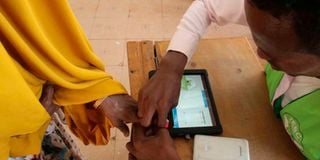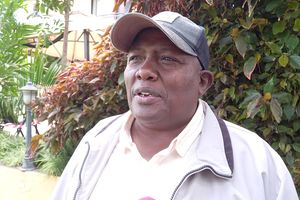Premium
Perennial server headache rears head in 2022 petition

A polling clerk uses a Kiems kit to identify a voter.
For a fourth successive presidential election, disgruntled voters asked the Supreme Court to order for scrutiny of the electoral body’s technology systems in a bid to prove interference with results.
Former Prime Minister Raila Odinga, activists Khelef Khalifa and Youth Advocacy Africa asked the Supreme Court to scrutinise the Independent Electoral and Boundaries Commission (IEBC) servers in the 2022 election petition.
The process did not yield much and the Supreme Court ruled that there was no evidence gathered that could prompt nullifying President William Ruto’s victory.
The court’s orders, however, caused confusion when Venezuelan firm Smartmatic refused to grant access to its servers for scrutiny, citing potential violation of intellectual property rights. In its detailed judgment, the Supreme Court has now suggested that servers supporting the General Election and those storing internal administrative work should be separated. This, the judges say, could help in scrutiny of servers supporting the election process in the event of a petition for nullification of results.
Mr Odinga’s lawyers had insisted that they were only granted partial access to IEBC servers, a move that allegedly blocked them from gathering crucial evidence.
“To avoid suspicion from stakeholders, unless where and when it is absolutely necessary, access to the servers supporting the transmission and storage of Forms 34A, 34B and 34C should be restricted to IEBC staff during the election period,” the court said.
“IEBC should ensure that the servers supporting the elections and those serving their internal administrative work are distinct and separate. This would then allow the court, should the need arise, to carry out forensic imaging of the same without compromising and/or infringing any third-party agreements,” the court added.
The scrutiny was ordered to verify whether results transmission forms uploaded onto the IEBC portal were the same as physical copies.
It found no major variances. The Supreme Court has also suggested that the IEBC trains its staff to ensure that they fill the results transmission forms and avoid errors when stating the total number of valid votes cast.
“IEBC may consider simplifying and restructuring the Forms 34A and include a column that accounts for stray ballots. In addition, it may consider having only one section for total valid votes. The independent body may also find it prudent to thoroughly train its returning officers as to what constitutes valid votes per this court’s decision,” the judges went on to say.





